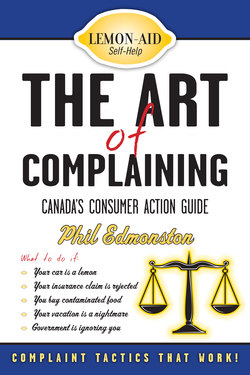Читать книгу The Art of Complaining - Phil Edmonston - Страница 2
На сайте Литреса книга снята с продажи.
Introduction
ОглавлениеWhen complaints are freely heard, deeply considered and speedily reformed, then is the utmost bound of civil liberty attained that wise men look for.
— John Milton
Canadians complain just as much as Americans, but not as well. Americans fight back hard — with small claims and class action lawsuits, with mass demonstrations, and with media manipulation. In Canada, we are, well, Canadian. Our grievances are politely aired and, if they are not acted upon, we vow to take our business elsewhere. Granted, sometimes we will collectively forge institutional solutions to problems (such as making healthcare available to everyone, selling our products, and protecting our culture). But individually, we tend to be pushovers.
In 2009, a Canadian survey of consumers from twenty-three countries sought to identify which population complained the most. Overall, 38 percent of participants had complained about a product or service in the past year. Brazilians were most likely to complain (65 percent); Canadians and Americans were slightly above average (44 percent); and Japanese consumers were least likely to air their grievances (17 percent).
Percentage of respondents who lodged a consumer complaint in the last year, by country:
| Consumer Complaints | |||||
| % | % | % | |||
| Brazil | 65 | Canada | 44 | South Korea | 32 |
| Mexico | 56 | Australia | 40 | Belgium | 29 |
| Argentina | 49 | Italy | 39 | Poland | 26 |
| India | 47 | France | 38 | Hungary | 25 |
| Czech Republic | 47 | Sweden | 36 | Turkey | 22 |
| Spain | 46 | Netherlands | 35 | Russia | 18 |
| Britain | 45 | Germany | 34 | Japan | 17 |
| U.S. | 44 | China | 32 |
Source: Ipsos Reid survey, May 2009
These findings suggest there is no difference in the percentage of dissatisfied Canadian and American consumers. The difference comes, however, in how we complain.
In January 2012, CBC’s Marketplace aired a story that used a hidden camera in one Toronto store to test customers’ limits with awful customer service. They found, in general, that customers were patient and unwilling to complain about the service they were getting (www.cbc.ca/news/yourcommunity/2012/01/how-do-you-react-to-terrible-customer-service.html).
The test demonstrated that although Canadians may be just as dissatisfied as Americans over faulty products, dangerous and unreliable automobiles, contaminated food, and unsatisfactory service, we prefer not to be seen as the squeaky wheel — at least, not overtly. As veteran Toronto Star consumer columnist and author Ellen Roseman pointed out, the difference is clear: “We’re not big complainers; we grumble and tell our friends.”
This book seeks to change all that. In the pages that follow, you will learn to see complaining in a new light:
In Chapter 1, you will discover the many benefits of complaining, be inspired by the success stories of other complainers, and learn when complaints are justified.
In Chapter 2, you will be introduced to your legal rights with accurate and up-to-date summaries of consumer-rights legislation and related judicial decisions.
Chapter 3 will take you through step-by-step instructions for effective consumer complaining — enabling you to act individually to get a refund for an unsatisfactory product or service.
The process outlined in Chapter 4 will help you to understand the benefits of collective complaining and will outline the process through which effective outcomes can be achieved.
Chapter 5 offers a guide for using the court system as a vehicle to satisfy customer complaints, providing practical information about choosing an appropriate venue, anticipating costs, and handling the actual litigation.
In Chapter 6, you will find specific information pertaining to complaints in the areas of vehicles, vacations, health care, and electronics.
My hope is that with all the support, encouragement, and concrete information and tips contained in this book, Canadians will feel more comfortable about standing up for their rights as consumers — in short, voicing their complaints in a way designed to reap effective results.
